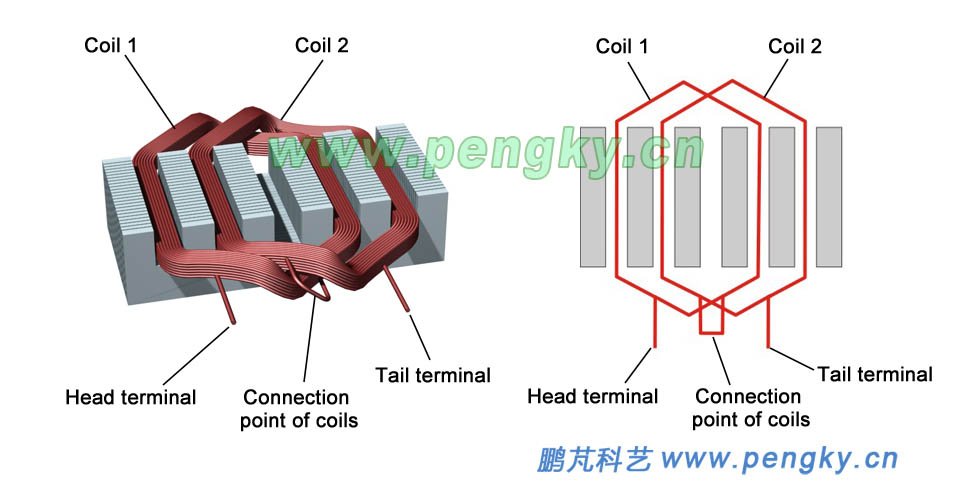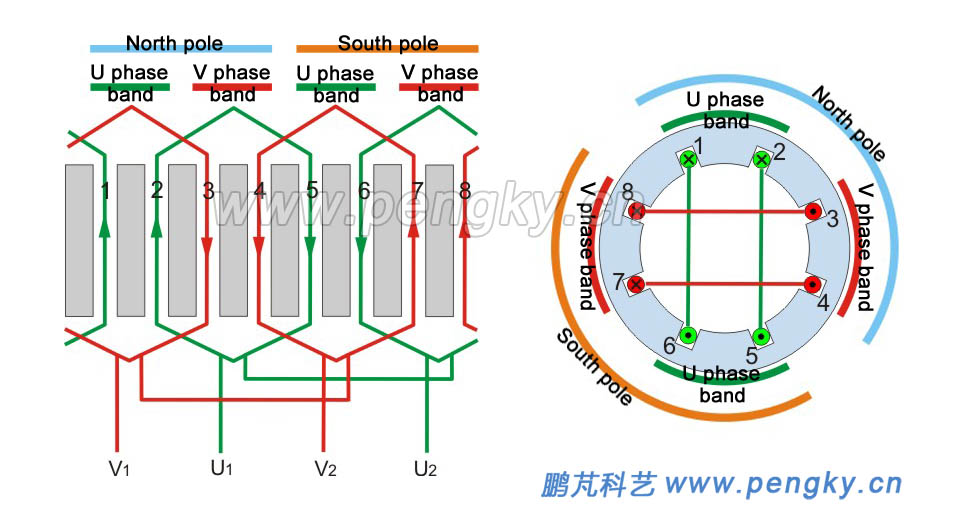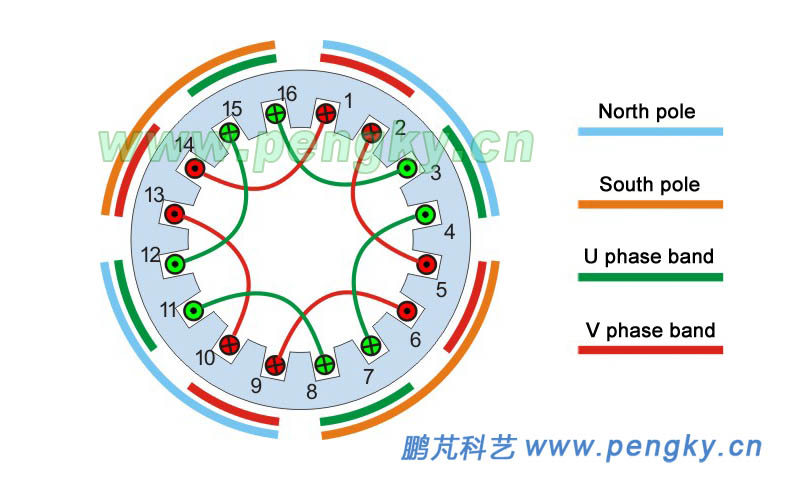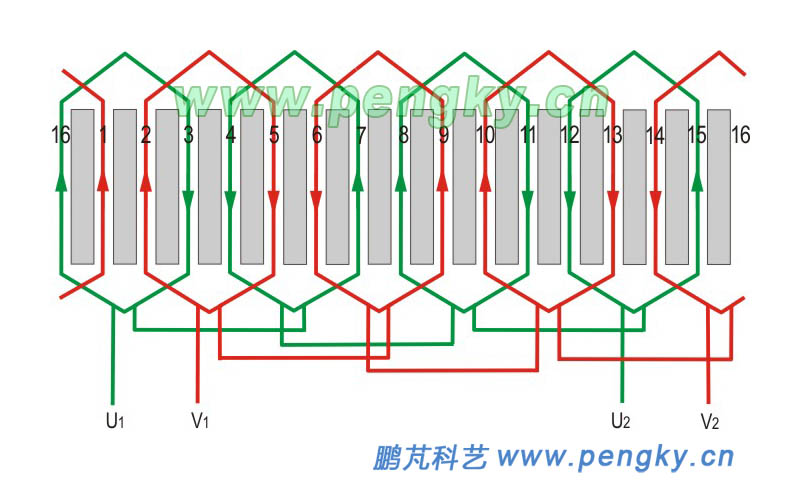
| AC Motor Winding |
For the generator, the winding is the component that generates the electromotive force, for the motor, the winding is the component that generates the mechanical force. Obviously the winding is the main component of the energy conversion and the most important component, the core of both stator and rotor is just used to reduce magnetic force and increase the magnetic path of magnetic flux. AC motors mainly have single-phase motors and multi-phase motors, and three-phase motor is mainly multi-phase motor. The principle of three-phase AC generator is introduced in this column "Three-phase AC generator principle model”, and the characteristics of three-phase alternating current are introduced in the motor column, "Rotating magnetic field generated by three-phase AC motor”, the model there uses a single-turn wire to represent winding, there is a little difference from the actual application In this course, we introduce the basic structure of the actual AC motor winding. Figure 1 is a stator core of an AC motor, which is formed by stacking a plurality of stamped silicon steel sheets, and teeth and grooves are evenly distributed on the inner circumference of the core, and the stator winding are embedded in the slots. |
 |
| Figure 1 - AC motor stator core |
While the circumferentially arranged coil is difficult to view and analyze, as describing the arrangement and connection of a motor winding, it is usually represented by an expansion drawing, that is mean the core of the cylindrical surface is unfolded into a plane, and the windings distributed in the core slot are also expanded, it can be much more intuitive. The motor winding motor consists of a plurality of coils, and the representation of the coils in the expansion drawing is illustrated in figure 2. |

| Figure 2 - Representation of the coil |
The left part in figure 2 shows one coil on a core. The coil is made of a multi-turn wire, this is a multi-turn coil. The part embedded in the core groove is called the effective side, other part on both end is called terminal part, it can definite that the effective side of the coil is involved in cutting the main magnetic field, that is an effective part, meanwhile the coil only acts as an effective side when connecting the outer portion of the groove. The two ends of the coil are called the head end and the tail terminal, in this course, the head end and the tail end are defined under considering the winding direction. For simple and clear representation, wireframes are represent coils in the expansion drawing. The middle part in figure 2 shows the coil with only one turn in open wireframe (also used to represent multi-turn coils in complex figure), the right part of figure 2 shows a multi-turn coil with a closed wire frame. The number of slots in between two effective sides of one coil are spaced apart with calling pitch y, and the pitch of the coils in figure 2 is 3. |
| Winding classification |
According to the number of layers of the coil in the slot, it is divided into single layer winding, double layer winding, and multilayer winding. There are chain windings, concentric windings, cross windings the single layer winding, and stack windings and wave windings belong to the double layer winding, all of these are common classification. Single-layer winding, several coils of the same phase are stacked together, and the latter coil is stacked behind the previous coil. The right side of figure 3 is an expansion drawing. of the windings, and the left side figure 3 is an expanded three space diagram. |

| Figure 3 - Single-stack winding |
| Single layer concentric winding |
| Several coils of the same phase are arranged concentrically as needed, and figure 4 is an exploded three space diagram of two concentric coils |
 |
| Figure 4 - Stereo view of single-layer concentric winding |
| Figure 5 is an expansion drawing, with a winding composed of two concentric coils showing in the left side of figure 5,simple drawing is used in many expansion drawing,the middle side in figure 5 shows the connection of two coils by the direct connection method; the right side in figure 5 is a representation of the elimination of the connection line. |

| Figure 5 - Stereo view of single-layer concentric winding |
| Single layer chain winding |
| Several coils of the same phase are chained one by one as needed, and the right side of figure 6 is an expansion view of the winding, and the left figure is an expanded three space diagram. |

| Figure 6 - Single layer chain winding |
| Double layer stacked winding |
| The two coils are stacked on one side of the other according to the need, and the right side of figure 7 is an expansion drawing of the winding, and the left side is an expanded three space diagram. |

| Figure 7 - Double layer stacked windings |
| The above is just a common form of winding. Please refer to the information for other forms. |
| AC motor windings form the basis |
The specific windings in the AC motor are mainly based on the following data: Magnetic pole pair p Pole distance τ Phase band q |
| Single-phase AC motor winding |
| Since single-phase AC cannot generate a rotating magnetic field, the practical application is to divide single-phase AC into two-phase AC,U-phase and V-phase, and the phase difference between the two phases is 90 degrees, so the single-phase AC motor winding is actually a two-phase AC winding. The following is an example of the construction of a single-phase AC motor winding. |
| Single-phase 2-pole 8-slot single-layer chain winding |
The two-phase AC winding consists of two mutually perpendicular windings. For a 2-pole motor, there are two-phase windings. The simplest one is one winding and only one coil. The whole motor requires only two coils and four slots. The core utilization of only 4 slots is too low, the actual motor is at least 8 slots, the pole pitch is 4 for the 8 slots stator, and the phase band width is 2. |

| Figure 8--Single-phase 2-pole 8-slot single-layer chain windin | ||
| Single-phase 4-pole 16-slot single-layer chain winding | ||
| 4 poles is for single-phase motor whose speed is half as slow. The following example is a single-phase 2-pole 16-slot motor. If a single-layer chain winding is still used, no further analysis is performed, and only the wiring diagram is displayed. Figure 9 is a circular view, and figure 10 is an expansion drawing | ||
 |
||
| Figure 9--Single-phase 4-pole 16-slot single-layer chain winding circle | ||
 |
||
| Figure 10 - Single-phase 4-pole 16-slot single-layer chain winding expansion drawing | ||
| Single-phase 2-pole 16-slot single-layer concentric | ||
| Figure 11 is a circular diagram of a 2-pole 16-slot motor using a single-layer concentric winding, and figure 12 is an expansion drawing of a 2-pole 16-slot motor using a single-layer concentric winding. | ||
 |
||
| Figure 11--Single-phase 2-pole 16-slot single-layer concentric winding circle | ||
 |
||
| Figure 12 - Single-phase 2-pole 16-slot single-layer concentric winding expansion drawing | ||
| The windings of the three-phase AC motor will be described in the following courseware. | ||
| Back to Previous Page |
